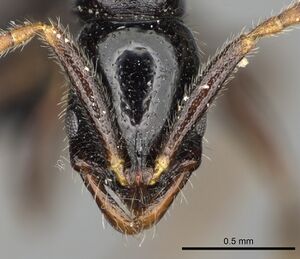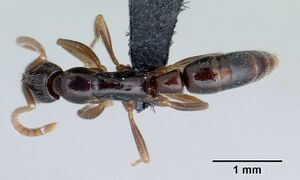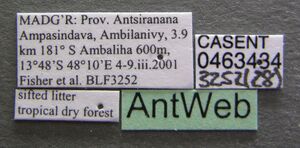Leptogenys fiandry
| Leptogenys fiandry | |
|---|---|

| |
| Scientific classification | |
| Kingdom: | Animalia |
| Phylum: | Arthropoda |
| Class: | Insecta |
| Order: | Hymenoptera |
| Family: | Formicidae |
| Subfamily: | Ponerinae |
| Tribe: | Ponerini |
| Genus: | Leptogenys |
| Species group: | fiandry |
| Species: | L. fiandry |
| Binomial name | |
| Leptogenys fiandry Rakotonirina & Fisher, 2014 | |
Specimens of L. fiandry have been sampled using the sifted litter method and pitfall traps. They are quite common in their habitats and have been found foraging on the ground, nesting under rocks and rootmat layers, and in rotten logs and sticks on the forest floor.
Identification
A member of the fiandry species group. Rakotonirina and Fisher (2014) - Worker. Eye small, maximum width less than maximum diameter of antennal scape; body smooth and shining; mandible smooth and shining; masticatory margin with two teeth, one apical and the second preapical; mesopleuron and lower half of sides of propodeum densely and finely reticulate-rugulose; node approximately as high as long in profile; posterior margin of propodeum with distinct toothlike lobe; dorsum of body with slender erect hairs.
Workers of Leptogenys fiandry are similar to those of Leptogenys alamando but are easily separable by the presence of two teeth on the apical portion of its mandible and its complex subpetiolar process, which consists of one anterior tooth and a second posterior lobe. Leptogenys alamando’s mandibular masticatory margin is armed with three teeth, and its subpetiolar process lacks the second posterior lobe.
Keys including this Species
Distribution
Leptogenys fiandry is widely distributed across different habitats in the northern half of Madagascar. These range from dry forest, particularly in Tsingy, to transitional humid and littoral forests, as well as montane rainforest. Comoros Island is also known to harbor the species.
Latitudinal Distribution Pattern
Latitudinal Range: -12.790139° to -13.2117°.
| North Temperate |
North Subtropical |
Tropical | South Subtropical |
South Temperate |
- Source: AntMaps
Distribution based on Regional Taxon Lists
Malagasy Region: Madagascar (type locality).
Distribution based on AntMaps
Distribution based on AntWeb specimens
Check data from AntWeb
Countries Occupied
| Number of countries occupied by this species based on AntWiki Regional Taxon Lists. In general, fewer countries occupied indicates a narrower range, while more countries indicates a more widespread species. |

|
Estimated Abundance
| Relative abundance based on number of AntMaps records per species (this species within the purple bar). Fewer records (to the left) indicates a less abundant/encountered species while more records (to the right) indicates more abundant/encountered species. |

|
Biology
|
Castes
Worker
Images from AntWeb
   
| |
| Holotype of Leptogenys fiandry. Worker. Specimen code casent0247245. Photographer Estella Ortega, uploaded by California Academy of Sciences. | Owned by CAS, San Francisco, CA, USA. |
   
| |
| Worker. Specimen code casent0147308. Photographer Erin Prado, uploaded by California Academy of Sciences. | Owned by CAS, San Francisco, CA, USA. |
   
| |
| Worker. Specimen code casent0463434. Photographer Jean Claude Rakotonirina, uploaded by California Academy of Sciences. | Owned by CAS, San Francisco, CA, USA. |
Nomenclature
The following information is derived from Barry Bolton's Online Catalogue of the Ants of the World.
- fiandry. Leptogenys fiandry Rakotonirina & Fisher, 2014: 70, figs. 7B, 9A, 87, 92 (w.q.) MADAGASCAR.
Unless otherwise noted the text for the remainder of this section is reported from the publication that includes the original description.
Description
Worker
(16 specimens). HW: 0.60–0.69, HL: 0.74–0.99, CI: 66–85, SL: 0.65–0.86, SI: 109–131, PW: 0.47–0.59, WL: 1.23–1.48, PNH: 0.38–0.50, PNL: 0.42–0.50, PNW: 0.36–0.44, DNI: 81–91, LNI: 90–106.
Head elongate and very slightly diverging anteriorly, lateral borders nearly parallel to each other. Eye small, maximum width less than greatest width of antennal scape. Anteromedian clypeal margin projecting into triangular lobe. Mandible short and armed with two teeth, apical and preapical; blades widest at insertion of preapical tooth. Antennal scape short, feebly extending beyond posterior cephalic margin. In lateral view, posterior margin of propodeum with small toothlike lobe. In profile, petiolar node roughly as high as long; subpetiolar process consisting of anteroventral tooth followed by an indentation and then a posterior lobe. At anteroventral angle of third abdominal segment, prora projecting into sharp, ventrally directed lobe. Mandible smooth and shiny with scattered punctures. Dorsum of head, mesosoma and petiolar node smooth and shining besides very small piligerous pits. Anterior half of mesopleuron and propodeum generally finely reticulate in profile, sometimes mesopleural suture surrounded by fine reticulation. Sparse long hairs and short erect hairs present on scape and dorsum of body. Body color blackish dark-brown to brown with lighter appendages and apex of gaster.
Queen
(3 specimens). HW: 0.68–0.74, HL: 0.94–0.99, CI: 72–74, SL: 0.72–0.79, SI: 106–114, PW: 0.57–0.62, WL: 1.33–1.39, PNH: 0.47–0.49, PNL: 0.33–0.38, PNW: 0.46–0.47, DNI: 123–139, LNI: 124–148. Ergatoid queens look very similar to workers, but differ in the following characters: ergatoids have a broader and more ovoid head, shorter and robust mesosoma with decreased development of thoracic sclerites, shorter petiolar node, and enlarged gaster. With gaster in profile, helcium slightly higher on anterior margin of third abdominal segment. Hairs on dorsum of body more abundant and somewhat long and more slender.
Type Material
Holotype worker: Madagascar, Antsiranana, Forêt d' Antsahabe, 11.4 km 275° W Daraina, -13.2117, 49.5567, 550 m, tropical dry forest, ex rotten log, 14 Dec 2003 (B.L. Fisher et al.) collection code: BLF10234, specimen code: CASENT0247245 (California Academy of Sciences). Paratypes: series of 7 worker specimens, same data as holotype but with the following specimen codes: CASENT0076745, CASENT0076746, CASENT0076747, CASENT0247243, CASENT0247244, CASENT0247246, CASENT0196531 (CASC, The Natural History Museum, Musee d'Histoire Naturelle Genève, Parc Botanique et Zoologique de Tsimbazaza).
References
- Rakotonirina, J.C. & Fisher, B.L. 2014. Revision of the Malagasy ponerine ants of the genus Leptogenys Roger (Hymenoptera: Formicidae). Zootaxa 3836, 1-163.
References based on Global Ant Biodiversity Informatics
- Goodman S., Y. Anbdou, Y. Andriamiarantsoa, B. L. Fisher, O. Griffiths, B. Keitt, J. J. Rafanomezantsoa, E. Rajoelison, J. C. Rakotonirina, L. Ranaivoarisoa et al. 2017. Results of a biological inventory of the Nosy Ankao island group, Parc National de Loky-Manambato, northeastern Madagascar. Malagasy Nature, Association Vahatra, 2017, 11, <http://www.vahatra.mg/volume11fr.html>
- Rakotonirina J. C., and B. L. Fisher. 2014. Revision of the Malagasy ponerine ants of the genus Leptogenys Roger (Hymenoptera: Formicidae). Zootaxa 3836 (1): 001163.

